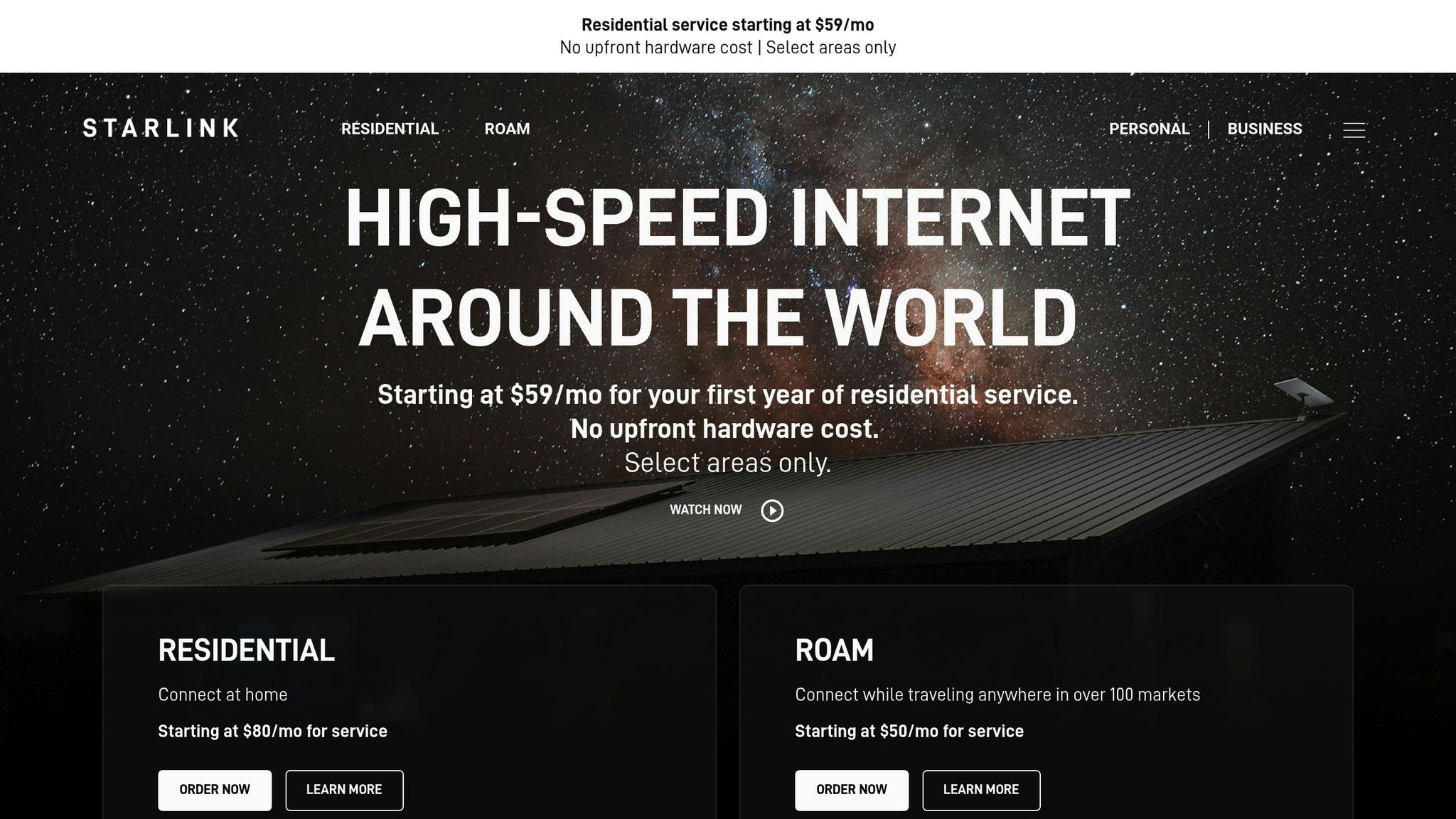SpaceX Financial Performance: Key Takeaways
Explore SpaceX's financial growth driven by Starlink and launch services, alongside risks and future outlook for interplanetary exploration.

SpaceX has positioned itself as a dominant force in the private space industry, with a valuation of $350 billion in 2024 and projected revenue of $15.5 billion for 2025. Here's what you need to know:
- Revenue Growth: SpaceX's revenue jumped 63% from $8.7 billion in 2023 to $14.2 billion in 2024, driven by Starlink and launch services.
- Starlink's Role: Starlink now generates 58% of total revenue, with $7.7 billion in 2024 and a projected $12.3 billion in 2025. Its subscriber base has grown to 8.5 million globally.
- Launch Services: Falcon 9 and Falcon Heavy launches generated $5.5 billion in 2024, supported by SpaceX's cost-efficient, vertically integrated operations.
- Investor Insights: SpaceX is valued at 25x revenue multiples, reflecting high investor confidence. Pre-IPO opportunities remain a major draw for private equity investors.
SpaceX's ability to balance revenue streams, control costs, and scale operations continues to fuel its growth trajectory, with ambitions extending to interplanetary exploration.
Revenue Growth and Key Financial Metrics
Annual Revenue and Growth Trends
SpaceX has been on an impressive trajectory when it comes to revenue growth. In 2023, the company pulled in $8.7 billion, which surged to $14.2 billion in 2024 - a 63% year-over-year increase. This growth hints at SpaceX entering a phase of more stable expansion as its key revenue streams mature. Looking ahead, SpaceX is expected to reach $15.5 billion in revenue by 2025. These figures provide a clear picture of the company's evolving revenue dynamics.
Revenue Sources Breakdown
Over the last few years, SpaceX's revenue sources have shifted significantly, with Starlink taking center stage as the company's primary income driver. In 2024, Starlink contributed $7.7 billion, making up 58% of the company's total revenue.
Launch services also saw substantial growth, generating $5.5 billion in 2024, compared to $3.5 billion in 2023. Projections for 2025 suggest that Starlink's share of total revenue will grow to 70%, with launch services and government contracts making up the rest. By that time, Starlink alone is forecasted to bring in $12.3 billion.
Government contracts continue to play a steady role in SpaceX's financial portfolio. In 2023, commercial launches accounted for approximately $800 million, while three crewed missions added another $780 million.
| Revenue Source | 2023 | 2024 | 2025 (Projected) |
|---|---|---|---|
| Total Revenue | $8.7B | $14.2B | $15.5B |
| Starlink | ~$4.2B | $7.7B | $12.3B |
| Launch Services | $3.5B | $5.5B | ~$3.2B |
| Starlink % of Total | ~48% | 58% | ~70% |
This diverse revenue mix is a cornerstone of SpaceX's financial stability and growth.
Profit Margins and Financial Health
SpaceX's financial strength is closely tied to its ability to manage costs and operate efficiently. The company’s vertical integration strategy has been key to reducing expenses, allowing SpaceX to maintain healthy profit margins while keeping its pricing competitive.
Starlink's subscription-based model has proven to be a reliable source of recurring revenue with strong margins. For instance, residential customers pay about $2,000 annually, maritime users spend around $34,000, and aviation customers are billed roughly $300,000 per year.
SpaceX’s operational reliability is another critical factor. With a 99% success rate across 315 missions, the company has built a reputation for dependability. This operational excellence is reflected in its valuation, with SpaceX trading at 25x revenue multiples and approximately 100x EBITDA multiples. Such metrics highlight the confidence investors have in the company’s long-term potential.
SpaceX 2025 Business Outlook

Starlink's Role in SpaceX's Financial Success

Starlink has become a key driver of SpaceX's financial growth, thanks to its rapid expansion in subscribers and a reliable revenue model that keeps cash flowing steadily.
Rapid Subscriber Growth and Expanding Market Reach
Since its beta launch, Starlink has seen explosive growth, skyrocketing from 10,000 users in 2021 to an impressive 8.5 million global subscribers by September 2025. Within the residential market, Starlink has captured a 0.2% share with 4.4 million subscribers. In specialized sectors like maritime and aviation, it holds a 0.7% market share. Operating across 140 countries, Starlink not only brings connectivity to underserved areas but also attracts major enterprise clients such as United Airlines and Deere. This surge in subscribers directly contributes to Starlink’s consistent revenue stream, which is critical to SpaceX's broader financial strength.
Reliable Revenue Through Subscription Models
Starlink’s subscription-based model provides a steady and predictable cash flow, which helps fund SpaceX's research and development efforts. Its tiered pricing system allows for flexibility, accommodating residential customers while also targeting high-value enterprise clients. These specialized customers generate significantly higher average revenue compared to residential users, creating a balanced and lucrative revenue mix. This financial stability strengthens investor confidence in SpaceX's long-term growth potential.
A Competitive Edge in Satellite Internet
Starlink has positioned itself as a technological leader in the satellite internet space. Offering speeds of up to 215 Mbps - far outpacing competitors like Viasat’s 20 Mbps - it also benefits from its low Earth orbit satellite constellation, which ensures better latency and wider global coverage. Starlink’s cost efficiency further solidifies its market position; the price of user terminals has dropped to $349, and SpaceX now manufactures over 1 million terminals annually. With more than 9,000 satellites deployed as of August 2025, Starlink boasts the largest commercial satellite network in the world.
For those looking to understand the investment potential of these advancements, the SpaceX Stock Investment Guide offers valuable insights into SpaceX’s valuation, stock trends, and private equity opportunities. Additionally, Starlink's move into direct-to-cell services could unlock new revenue streams, further cementing its role as a leader in global connectivity. These technological and financial advantages continue to fuel SpaceX’s momentum in the industry.
Launch Services and R&D Investments
Starlink's steady income stream is just one piece of SpaceX's financial puzzle. The company's launch services are a driving force behind the innovation fueling its ambitious goals. Revenue from Falcon 9 and Falcon Heavy missions creates a self-sustaining cycle, funding research and development for advanced spacecraft and technologies aimed at interplanetary exploration.
Falcon 9 and Falcon Heavy: Redefining Space Access
SpaceX has reshaped the economics of space travel with its groundbreaking reusable rocket technology. The company has achieved a commanding position in the market by combining reliability with affordability, boasting an impressive 99% success rate across 315 launches. In 2024 alone, SpaceX completed a record-breaking 134 launches and is setting its sights on 170 launches in 2025, showcasing the scalability of its operations.
One of the secrets to this success is SpaceX's vertical integration. By controlling 70% of its value chain - from rocket design to launch execution - the company has slashed costs and accelerated innovation. This in-house approach allows SpaceX to price Falcon 9 launches at $62 million and Falcon Heavy missions at approximately $125 million, a stark contrast to the industry average of $400 million per launch.
In 2024, launch services brought in $5.5 billion, contributing significantly to SpaceX's overall revenue. Profits from both commercial launches and crewed missions are reinvested into cutting-edge R&D and long-term plans for interplanetary exploration.
Financing the Future
Unlike many traditional aerospace companies, SpaceX relies on its own revenue to fund projects, minimizing the need for external financing. In its early days, the company used launch revenues - $10-12 million per Falcon 1 launch - to overcome challenges and fund the development of Falcon 9 and Falcon Heavy. Today, profits from its thriving launch operations are being funneled into the development of Starship and plans for interplanetary missions.
SpaceX's approach to innovation is fast and cost-efficient, thanks to its rapid prototyping model. This strategy allows the company to iterate on new technologies quickly while maintaining full control over quality and timelines.
As Starlink's growth eventually levels off, SpaceX plans to redirect future profits toward building Mars infrastructure and advancing interplanetary exploration projects. The company's current valuation, based on employee share sales, hovers between $350-400 billion. For those interested in the financial side, resources like the SpaceX Stock Investment Guide offer insights into how revenue from launch services impacts investment opportunities and stock valuation.
This financial strategy gives SpaceX the freedom to pursue ambitious goals, such as fully reusable spacecraft and Mars colonization. With a proven launch business as its financial backbone, the company is well-positioned to push the boundaries of space exploration and technological innovation for years to come.
Risks, Challenges, and Future Outlook
SpaceX's impressive financial performance comes with its fair share of challenges. These potential hurdles could influence its growth trajectory and the sustainability of its current valuation, estimated between $350–400 billion. Understanding these risks is essential for assessing the company's long-term prospects.
Regulatory and Competitive Risks
Operating in a tightly regulated industry, SpaceX faces obstacles tied to international compliance and geopolitical issues. For example, Starlink has encountered difficulties obtaining regulatory approval and spectrum rights in countries with stringent telecommunications laws or strained relations with the United States. In some cases, national security concerns have led to delays or outright bans, which could limit Starlink's subscriber growth.
The classified nature of SpaceX's Starshield satellites also raises regulatory concerns. Operating on the uplink-only 2025–2110 MHz band, these satellites could attract heightened scrutiny from both domestic and foreign authorities, potentially affecting the company's market access and public perception.
Competition adds another layer of complexity. In the launch services sector, rivals like Blue Origin, Rocket Lab, and China's CASC are advancing their capabilities. Meanwhile, in the satellite internet market, established players such as Viasat, Intelsat, and OneWeb are stepping up efforts to challenge Starlink. This competitive pressure might force SpaceX to adjust its pricing strategies or increase spending on research and development, potentially impacting profit margins.
Operational risks remain a constant concern. A significant failure - whether involving a Falcon 9 rocket or the Starship program - could disrupt operations, delay customer deliveries, and harm SpaceX's reputation. Additionally, supply chain issues and manufacturing bottlenecks could hinder the company's ability to scale effectively.
Financial Projections and Market Expansion
Looking ahead, SpaceX's financial outlook suggests both opportunities and uncertainties. The company is projected to generate $15.5 billion in revenue by 2025, up from $14.2 billion in 2024. Starlink is expected to account for a substantial 70% of this revenue, contributing $12.3 billion in 2025 compared to $7.8 billion in 2024.
Key assumptions driving these projections include a growing Starlink subscriber base, which is anticipated to exceed 8.5 million by September 2025, up from 4.6 million in 2024. SpaceX also aims to increase its launch frequency to 170 missions in 2025, a 27% jump from the 134 launches completed in 2024.
SpaceX is also exploring new revenue streams to diversify its income. Plans include direct-to-cell satellite services through partnerships with mobile network operators, as well as logistics and space-based data services. These initiatives could help reduce reliance on traditional launch and broadband markets.
Despite these promising projections, the long-term outlook remains speculative. Investment models estimate a base case valuation of $2.5 trillion by 2030 - six times the current figure. By 2040, this could grow to $12.8 trillion, roughly equal to the combined market caps of NVIDIA, Microsoft, and Apple today. While these numbers highlight SpaceX's potential, they also underscore the uncertainties of forecasting in the space industry.
Investment Opportunities
Even with these challenges, SpaceX's financial growth and technological leadership make it a compelling investment opportunity. Its rapid revenue growth, driven largely by Starlink's subscription model, and its pioneering reusable launch technology create a strong case for investors.
SpaceX's vertical integration strategy is another key advantage, as the company controls 70% of its value chain - something traditional aerospace firms struggle to achieve. This approach helps SpaceX maintain control over costs and operations, giving it a competitive edge.
Starlink's business model also supports its investment appeal. With average revenue per user at $2,000 for residential services, $34,000 for maritime, and $300,000 for aviation, there’s significant room for market share growth. Currently, Starlink holds just 0.2% of the residential broadband market and 0.7% in both maritime and aviation sectors, indicating untapped potential.
For those interested in pre-IPO investments, resources like the SpaceX Stock Investment Guide provide valuable insights into the company’s valuation methods and private market strategies.
Adding to its allure, SpaceX's long-term vision includes redirecting profits from Starlink toward building infrastructure for Mars colonization. While this presents an ambitious growth story, it also introduces risks tied to the technological and financial demands of interplanetary exploration.
With projected 2025 revenues nearing NASA's proposed 2026 budget of $18.8 billion, SpaceX is solidifying its position as a leader in space exploration and commercialization. Its diversified revenue streams, proven execution, and bold vision make it a standout investment opportunity for those with access to pre-IPO shares.
Key Takeaways
Looking at the numbers and strategies, SpaceX's evolution tells a story of blending diverse revenue streams with bold technological advancements, reshaping the space industry as we know it. By December 2024, the company reached a staggering $350 billion valuation, cementing its status as a leader in commercial space ventures.
Starlink plays a pivotal role here. Beyond just generating revenue, it ensures a steady, recurring cash flow - something traditional, project-based launch services can't provide. This shift toward diversified income sources has given SpaceX a more stable and adaptable business model, capable of supporting its ambitious long-term goals.
SpaceX's focus on vertical integration has been a game-changer. By streamlining operations and keeping much of the production in-house, the company has managed to cut costs significantly. This approach not only allows SpaceX to offer competitive pricing but also helps maintain healthy profit margins, which fuel its bold investment plans.
Looking ahead, the numbers are eye-opening. Analysts project SpaceX could hit a valuation of $2.5 trillion by 2030 and a staggering $12.8 trillion by 2040. Current revenue multiples of 25x reflect the high expectations and confidence investors have in the company's performance. For those interested in investing before an IPO, resources like the SpaceX Stock Investment Guide offer valuable tools and community support to navigate private market opportunities with SpaceX and Starlink.
SpaceX is now operating on a scale comparable to major government space agencies, showcasing how private companies are increasingly driving space exploration with sustainable and forward-thinking business models.
FAQs
How does SpaceX's vertical integration drive its financial success and strengthen its competitive edge?
SpaceX's approach to vertical integration has been a game-changer for its financial performance and competitive edge. By handling the manufacturing of most rocket components internally, the company minimizes dependence on third-party suppliers. This not only reduces costs but also ensures stricter control over quality and project timelines.
What’s more, this strategy fuels SpaceX’s ability to innovate quickly, respond to shifting market needs, and streamline its supply chain. Paired with its reusable rocket technology, vertical integration allows SpaceX to offer cost-efficient solutions for satellite launches, space exploration, and other services. This combination has firmly established SpaceX as a leader in the aerospace world.
What risks does SpaceX face by relying heavily on Starlink for revenue?
SpaceX's dependence on Starlink for a large share of its revenue comes with its fair share of challenges. One of the biggest hurdles is the hefty cost of deploying and maintaining the satellite network. This kind of operation demands constant investment, which can weigh heavily on profitability.
Competition in the satellite internet industry is another factor that could affect Starlink's growth. As more players enter the market, staying ahead will require continuous improvements and strategic maneuvers to retain users and maintain a competitive edge.
On top of that, regulatory barriers in various countries could slow down Starlink's global rollout. Different nations have different rules, and navigating these can be both time-consuming and complex. Technical setbacks, like satellite malfunctions or launch delays, also pose risks that could disrupt operations and revenue.
Even with these challenges, SpaceX pushes forward, expanding Starlink's reach and refining its technology to strengthen its foothold in the market.
How could SpaceX's interplanetary exploration plans influence its future financial performance and valuation?
SpaceX has set its sights on interplanetary exploration, with Mars missions being a key focus. These bold ventures could dramatically influence the company's financial future and overall valuation. By venturing beyond Earth's orbit, SpaceX could unlock fresh revenue opportunities, including lucrative government contracts, collaborations with commercial entities, and technological advancements that might find applications in other industries.
Of course, these ambitious plans come with hefty initial expenses. However, if SpaceX successfully carries out interplanetary missions, it could cement its position as a leader in the rapidly expanding space economy. This leadership could not only elevate its market valuation but also pave the way for long-term profitability. On top of that, achieving such milestones could inspire greater investor confidence, potentially drawing in more private equity funding to fuel future endeavors.
Comments ()